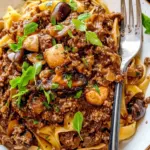Creamy scrambled eggs meet smoky Polish kielbasa in this rich and comforting breakfast classic. With minimal ingredients and maximum flavor, it’s a hearty dish that comes together in minutes—ideal for lazy weekend mornings or quick weekday meals.
Inspired by traditional Polish flavors, this dish is both nostalgic and satisfying. Serve it with crusty rye bread, pickles, or even fried potatoes to elevate it further. Whether you’re Polish or just love great breakfast food, this recipe will quickly become a favorite in your rotation.
Full Recipe
Ingredients:
-
6 large eggs
-
1/4 cup whole milk
-
1 tablespoon unsalted butter
-
6 oz Polish kielbasa, sliced into half-moons
-
1/4 cup yellow onion, finely chopped
-
1 tablespoon chopped chives (optional)
-
Salt and pepper to taste
Directions:
-
In a medium bowl, whisk together the eggs and milk until fully combined. Season with a pinch of salt and pepper.
-
Heat a nonstick skillet over medium heat and melt the butter.
-
Add the sliced kielbasa and cook for 3-4 minutes, stirring occasionally, until browned and heated through.
-
Add the chopped onion and sauté for another 2 minutes until softened.
-
Reduce the heat to low and pour in the egg mixture.
-
Gently stir the eggs with a spatula, pushing from the edges to the center, until soft curds form and the eggs are just set, about 3-5 minutes.
-
Remove from heat and sprinkle with chopped chives if using. Serve immediately with rye bread or your favorite toast.
Prep Time: 5 minutes | Cooking Time: 10 minutes | Total Time: 15 minutes
Kcal: 310 kcal | Servings: 2 servings
A Hearty Polish Classic: Scrambled Eggs with Kielbasa
Scrambled Eggs with Kielbasa is more than just a breakfast staple—it’s a warm, comforting dish deeply rooted in Eastern European culinary tradition. Combining creamy scrambled eggs with smoky, savory Polish sausage (kielbasa), this recipe brings together simple ingredients to create bold, satisfying flavors that can be enjoyed at any time of the day. Whether you’re diving into this dish for breakfast, brunch, or even a quick weeknight dinner, its rustic charm and ease of preparation make it a reliable favorite in any home kitchen.
Cultural Significance and Origins
Kielbasa is a beloved staple in Polish cuisine and carries centuries of history. While the word “kielbasa” simply means “sausage” in Polish, it refers to a wide variety of smoked or fresh sausages, often made with pork and seasoned with garlic, marjoram, and pepper. It’s a symbol of Polish food heritage and is commonly used in many household dishes—from soups and stews to breakfast plates.
The tradition of serving kielbasa with eggs likely stems from the hearty breakfasts consumed in rural Poland, where farmers needed energy-packed meals to fuel their workday. Eggs and sausage provided a protein-rich, sustaining start that’s still appreciated by people around the world today. Over time, Polish immigrants brought this combination with them to places like the United States, where it’s remained a comforting and nostalgic meal.
Flavor Profile and Texture
The beauty of this dish lies in its balance of textures and flavors. The scrambled eggs, when cooked slowly and gently, become soft, velvety, and rich. The kielbasa, often pan-seared until golden brown, adds a crispy edge and deep, smoky flavor that contrasts perfectly with the creaminess of the eggs. When cooked with onions, the dish gains a hint of sweetness that elevates the overall profile even more.
The key to this recipe’s success is simplicity. There are no complicated techniques or exotic ingredients. Just quality sausage, fresh eggs, and a little patience in the pan—and you get a breakfast that feels indulgent without being fussy.
Customization and Variations
What’s fantastic about this dish is its adaptability. While traditional versions stick to kielbasa, eggs, onions, and sometimes fresh herbs, there’s plenty of room to personalize the recipe based on your preferences or what’s in your fridge.
Want to make it a little lighter? Use turkey kielbasa or a chicken sausage alternative. Prefer a vegetarian option? You can substitute the kielbasa with seasoned tofu or mushrooms to maintain that savory, umami-packed flavor.
Feel free to add a handful of spinach or chopped tomatoes right before the eggs finish cooking for a pop of color and freshness. Cheese lovers might want to sprinkle shredded cheddar, gouda, or even Polish oscypek on top for a melty finish.
You can also adjust the consistency of the eggs—from softly scrambled with custard-like texture to a firmer, more cooked version depending on your taste. The richness of the eggs, paired with the smokiness of the sausage, makes any version satisfying.
Perfect Pairings and Serving Ideas
While this dish is often served on its own, it truly shines when paired with the right accompaniments. Traditionally, it’s enjoyed with slices of crusty rye bread or sourdough toast, which can be used to mop up every last bit of creamy egg and juicy sausage.
For a more filling meal, serve it alongside fried potatoes, sautéed cabbage, or a simple cucumber salad with dill and sour cream. These additions enhance the Polish essence of the dish and turn a humble breakfast into a complete, comforting meal.
Hot sauces, mustards, or pickled vegetables also work beautifully as condiments to cut through the richness of the sausage and eggs. For a brunch-worthy spread, pair this dish with coffee or a sparkling beverage like a mimosa or fresh juice to balance the savory notes.
When to Serve It
Though classically served for breakfast, Scrambled Eggs with Kielbasa is versatile enough to enjoy any time of day. It’s especially good for:
-
Weekend brunches when you want something hearty yet easy
-
Quick weeknight dinners that need minimal prep and cleanup
-
Late-night meals after a long day when comfort food is calling
-
Holiday mornings, particularly around Easter or Christmas, when traditional Polish foods are often on the table
Because it’s quick to prepare and uses ingredients you likely already have, it’s a practical go-to for both planned meals and spontaneous cravings.
Why This Recipe Works
At its core, Scrambled Eggs with Kielbasa is a recipe that balances comfort with efficiency. It’s:
-
Simple to prepare – even beginner cooks can master it quickly
-
Affordable – requires few, inexpensive ingredients
-
Nutritious – packed with protein and satisfying fats
-
Customizable – endless ways to personalize it to suit dietary needs or taste
-
Deeply flavorful – thanks to the smokiness of the kielbasa and richness of the eggs
It also has a universal appeal that crosses borders and breakfast tables alike. There’s something deeply satisfying about returning to a dish that’s stood the test of time and continues to bring joy to generations.
Tips for the Best Scrambled Eggs with Kielbasa
-
Low and slow: Cook your eggs on low heat for the creamiest texture. High heat can dry them out and make them rubbery.
-
Pre-cook the kielbasa: Browning the sausage first gives you crispy edges and releases flavorful fat that coats the onions and eggs.
-
Don’t over-season: Kielbasa is already seasoned. Taste before adding extra salt.
-
Freshness matters: Use fresh eggs for a richer taste and better texture.
-
Garnish smart: A sprinkle of chopped chives or fresh dill adds brightness and color to the final dish.
Health Considerations
While this recipe isn’t designed to be low-fat or low-calorie, it can still fit into a balanced diet. You can lighten it up by using fewer eggs or egg whites, leaner sausage varieties, and adding vegetables. Serving it with a whole grain side or salad can round out the nutritional profile.
If you’re watching your sodium intake, keep in mind that kielbasa can be salty, so you might skip additional salt or choose reduced-sodium versions of the sausage.
For those following gluten-free diets, this dish is naturally gluten-free—just be cautious with your sausage brand to ensure it doesn’t contain hidden gluten.
Conclusion
Scrambled Eggs with Kielbasa is a soulful dish that blends tradition, taste, and simplicity. It carries the warmth of a heritage recipe with the ease of modern preparation. Whether you grew up eating this in a Polish household or are just discovering its charm, it’s a recipe worth adding to your rotation.
Rich, flavorful, and endlessly adaptable, this dish is proof that some of the best meals come from the simplest combinations. With its short ingredient list and short prep time, it’s ideal for anyone looking for a comforting and filling meal that feels both familiar and special.
Add a little piece of Poland to your plate today—you won’t regret it.






